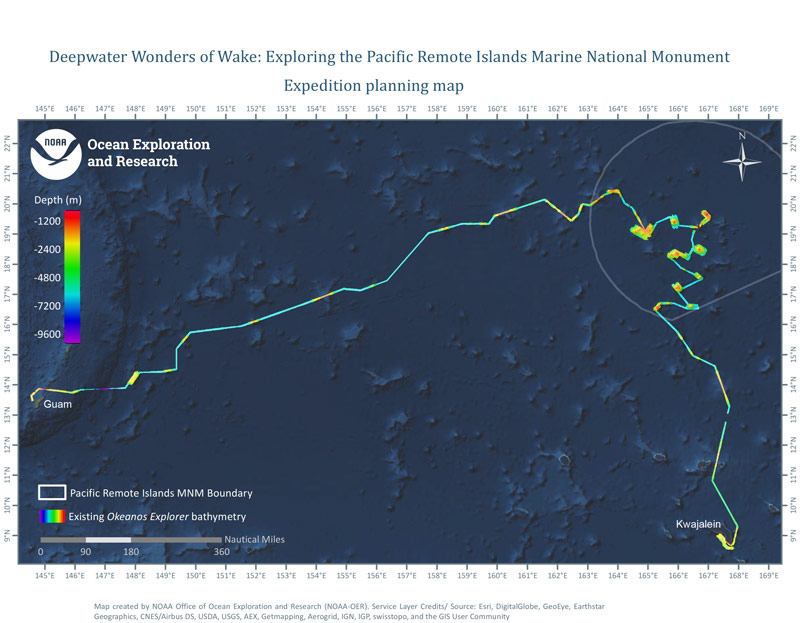
By Brian Kennedy, Expedition Coordinator, NOAA Office of Ocean Exploration and Research

This image shows the intended operating area for this expedition. The shaded area is the boundary of PRIMNM and the multi-color lines are bathymetry collected by via NOAA Ship Okeanos Explorer earlier this year. Image courtesy of the NOAA Office of Ocean Exploration and Research, Deepwater Wonders of Wake. Download larger version (pdf, 687 KB).
From July 27 through August 19, 2016, NOAA Ship Okeanos Explorer will explore largely uncharted deep-sea ecosystems and seafloor in and around the Wake Atoll Unit of the Pacific Remote Islands Marine National Monument (PRIMNM), now known as Pacific Islands Heritage Marine National Monument.
During the Deepwater Wonders of Wake: Exploring the Pacific Remote Islands Marine National Monument expedition, our at-sea and shore-based science teams will work together to make the some of the first deepwater scientific observations ever in this area. The expedition will commence in Apra Harbor, Guam, and conclude at Kwajalein Atoll in the Marshall Islands.
During the expedition, the NOAA Ship Okeanos Explorer team will be conducting telepresence-enabled remotely operated vehicle (ROV) and mapping operations. This cruise will result in critical baseline information to meet NOAA science and management needs within the Wake Atoll unit of PRIMNM.
Despite the role that the ocean plays in supporting our well-being, 95 percent of the world’s oceans remain unexplored. Increasing baseline knowledge of ocean habitats is critical to the conservation and preservation of these remarkable ecosystems. Exploratory missions, such as those conducted via Okeanos Explorer, are necessary to expand our knowledge of the unknown and to provide baseline data for resource managers.
This expedition will be particularly exciting because of virtually no work has been done below SCUBA-diving depths anywhere near Wake Atoll, meaning the expedition will be exploration in the truest form. Priority operating areas and science themes for this 24-day expedition were developed with input from scientists and managers across the broad ocean science community as part of NOAA’s multiyear Campaign to Address Pacific monument Science, Technology, and Ocean NEeds (CAPSTONE) project.
For this expedition, the Okeanos Explorer team will conduct 24-hour operations consisting of ROV dives and mapping. Daytime ROV operations will focus on depths between 250 and 6,000 meters and will include high-resolution visual surveys and limited geological sample collection. Mapping operations will be conducted overnight and when the ROV is on deck. ROV dives are planned, weather permitting, from July 30 – August 16 (following Fiji standard time).
NOAA Ship Okeanos Explorer uses telepresence technology to transmit data in real-time to a shore-based team of scientists who will be actively participating in the expedition. Access to video coming from the ship, combined with a suite of Internet-based collaboration tools, allow scientists on shore to help make minute-to-minute decisions and observations during each dive. Telepresence also allows the general public to follow the expedition online.
For this expedition, some researchers will be participating from their home institutions while others will travel to specialized locations called Exploration Command Centers (ECCs) during the cruise. ECCs expected to be online for the expedition including those at the University of Hawaii at Manoa; NOAA's Inuoye Regional Center in Hawaii; NOAA’s Offices in Silver Spring, Maryland; Harbor Branch Oceanographic Institution in Florida; Inner Space Center at the University of Rhode Island; and Stennis Space Center in Mississippi.
This expedition provides extensive opportunities for the public to connect to the mission. The web pages for this expedition will include background content; mission logs; daily updates; videos and images; and a live video feed. Educators and students can engage their classrooms through the Expedition Educational Module, which provides access to products tied to the expedition, including standards-based lesson plans, background information, ocean career connections, links to previous Office of Ocean Exploration and Research-sponsored expeditions, and more.